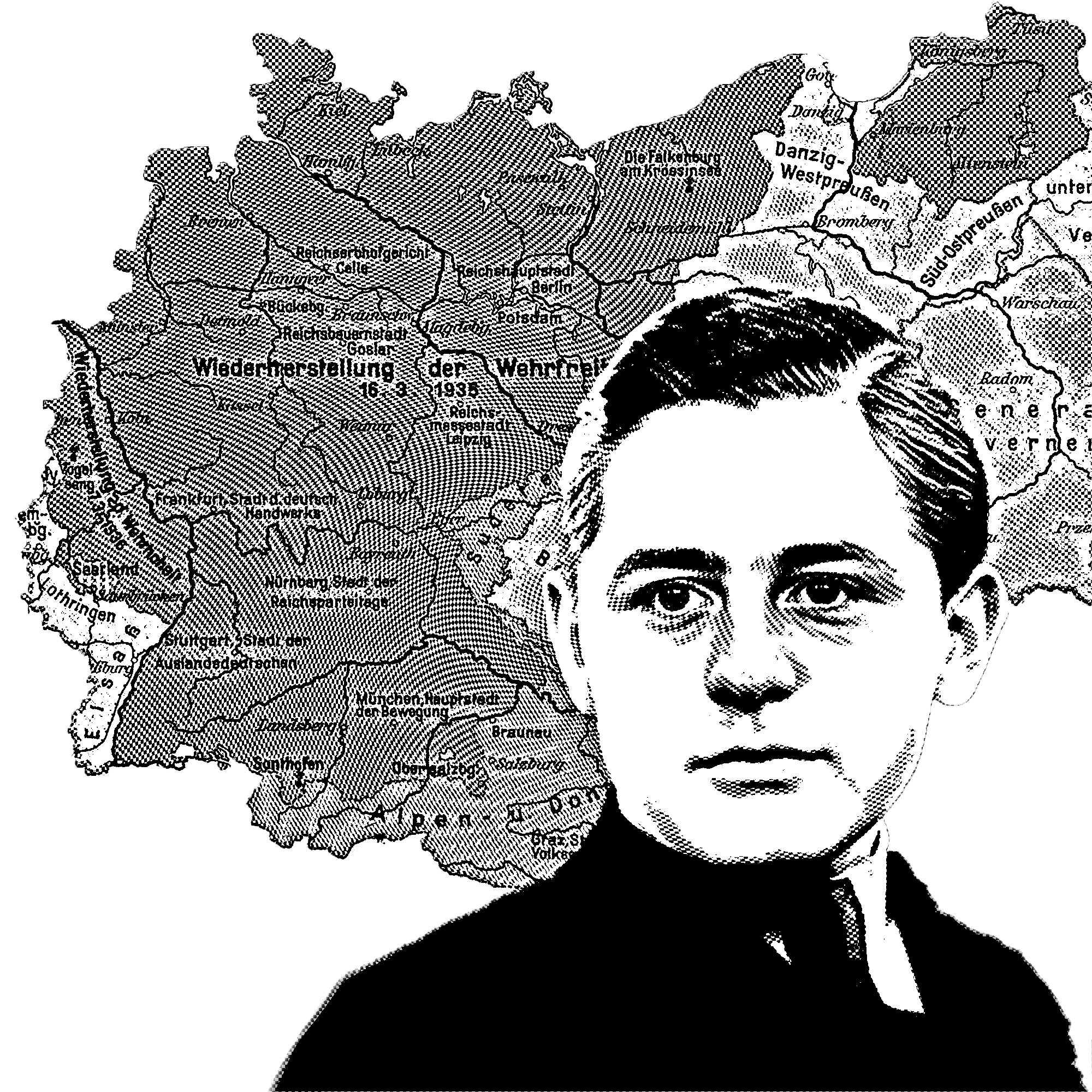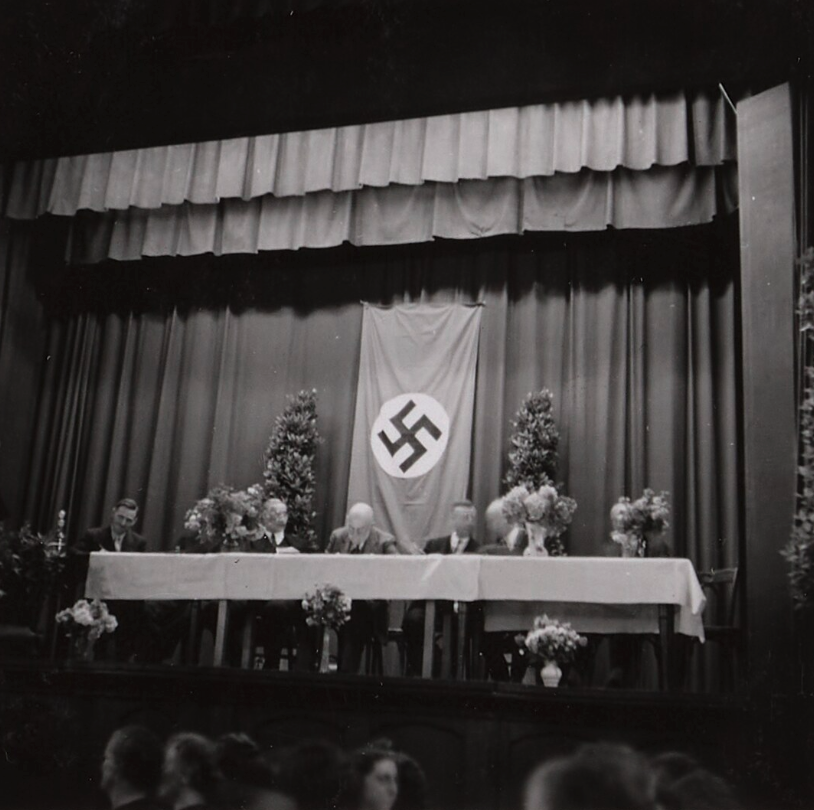Latter-day Saints and Nazi Germany

Latter-day Saints in Nazi Germany
1933–1939
The Pre-War Years
January 30, 1933
September 8, 1933
October 1933–January 1934
Nazi police in Germany begin reporting on LDS missionary activity and local church meetings in Germany.[5]
June 13, 1935
August 1935
The Nazi mayor of the town of Mildensee (Dessau) writes a letter to the Reich Minister for Public Enlightenment and Propaganda complaining about the presence of Latter-day Saints in his town.[7]
1935–1936
The Nazis continue spying on the Church in Germany.[8]
January 1936
Latter-day Saint missionaries coach the German national basketball team to prepare for the Berlin Olympics.[9]
April 30, 1936
Mission leaders meet with Nazi officials and are warned that "the strictest state police measures would be carried out against the sect" if the Church is ever suspected of being opposed to the Nazi regime.[10]
May 1936
Roy Welker writes letters to missionaries in Germany and to the Gestapo insisting on the Church's political neutrality and urging missionaries not to discuss politics.[11]
June 1936
A Latter-day Saint in Freiberg is arrested for refusing to give the Nazi salute or sing the national anthem after listening to one of Hitler's speeches at work.[12]
June 23, 1936
A former Latter-day Saint Nazi reports negatively on the Church while being interrogated by police.[13]
July 4, 1936
January 19, 1937
A police memorandum suggests banning the Church in Germany "on ideological grounds."[15]
April 1937
An internal government memorandum indicates that a general ban of the Church in Germany was being considered but deferred at that time for being "currently unfeasible."[16]
July 1937
May 5, 1938
April 14, 1939
1939–1945
The War Years
September 1, 1939
1939–1941
February 5, 1942
October 27, 1942
April–May, 1945
Hitler commits suicide in Berlin on April 30, 1945, and Germany formally surrenders to the Allied Powers one week later on May 8.[28]
Did the Church ever support the Nazi regime?
No. The Church of Jesus Christ of Latter-day Saints never endorsed the policies or beliefs of the National Socialist German Workers' (Nazi) Party.[31] In October 1942, the First Presidency condemned Nazism as coming from "wicked and designing men."[32]
There is no record of Church leaders ever instructing German Latter-day Saints to become Nazis or adopt Nazi ideology.[33] Church leaders emphasized the Church's neutrality in partisan politics[34] and encouraged missionaries not to participate in politics while serving in Germany.[35]
Are the teachings of the Church compatible with Nazism?
No. The teachings of the Church are fundamentally incompatible with the core tenets of Nazism.[36] In 1938, a report on the Church written to Nazi official Alfred Rosenberg concluded that "the teachings of the Mormons are incompatible with the National Socialist worldview."[37] The Nazis were especially disdainful of the Saints' friendliness towards Jews and their use of the Old Testament.[38][39]
But aren't there similarities between what the Church teaches and Nazism?
Some have pointed out similarities between some things the Church teaches and some aspects of Nazi ideology, such as an interest in family history, physical health, and obedience.[40][41]
But didn't some Church leaders say positive things about the Nazis?
Yes. Some Church leaders in Germany and the United States said positive things about certain aspects of Nazi rule in Germany, such as their emphasis on healthy living, genealogy, social orderliness, and collecting donations for the poor.[42]
However, other Church leaders were outspoken in their criticism of Nazism, such as David O. McKay,[BIO] who called Hitler a "murderous dictator,"[43] and John A. Widtsoe,[BIO] who called Hitler "mentally ill" and Nazi racial beliefs "an ugly delusion."[44][45]
The Nazis were aware of the overall negative feelings Church leaders had towards them.[46]
Is it true that missionaries helped coach the German basketball team for the 1936 Berlin Olympics?
Yes. In preparation for the 1936 Berlin Olympics, German authorities approached Latter-day Saint missionaries to help coach the national basketball team.[47] The missionaries accepted this offer as an opportunity to overcome opposition against the Church in Germany.[48]
Did the Church condemn Germany when World War 2 broke out?
The First Presidency condemned the war in general conference, but without specifically naming Germany,[49] saying that God would subject "eternal punishments" for those who waged war "unrighteously."[50]
Were Latter-day Saints more or less likely to be members of the Nazi party?
Less than 3% of German Latter-day Saints were members of the Nazi Party,[51] compared to the general German population, where membership was around 10%.[52]
Why would a Latter-day Saint become a Nazi?
Some listed reasons included personal belief in Nazism, antisemitic beliefs or feelings, pressure to join for social reasons, or as a requirement for government employment.[53][54]
What did the Nazis think of the Mormons?
The Nazi regime was suspicious and distrustful of the Church,[55] but as a general policy, they allowed the Church to continue operating in Germany between 1933 and 1945,[56] albeit with some restrictions.[57] Individual attitudes toward the Church among the Nazis ranged from cooperative to hostile.[58]
The Church was called a Sekte ("sect") by the Nazis,[59] which had both a technical and a pejorative meaning in Germany.[60]
Did the Nazis spy on the Church?
Yes. Internal reports and memoranda from the Nazi secret police (the Gestapo) indicate that Church members and activities in Germany were being monitored.[61] When President Heber J. Grant toured Germany and spoke to the Saints in Frankfurt and Berlin in 1937, he was monitored and his speeches recorded by Nazi agents.[62]
Were Latter-day Saints in Germany persecuted by the Nazis?
No, not as an official government policy.[63] However, there are individual accounts of Saints being harassed, threatened, or targeted by the Nazis,[64][65] and some Church literature was banned or confiscated.[66][67]
Did the Nazi government ever ban the Church or expel missionaries from Germany?
No, however records indicate that Nazi officials proposed banning foreign Latter-day Saint missionaries in Germany, and discussed a ban of the Church.[68]
Church leaders in Germany were explicitly warned by Nazi officials that if they engaged in any behavior considered to be adversarial to the government, the Church would face severe consequences.[69] A local Church leader in Hamburg was threatened by the Gestapo, who warned that if Germany won the war, the Church would be targeted next—just as the Jews had been.[70]
Were any German Saints sent to concentration camps?
Yes. Some Latter-day Saints were sent to concentration camps; not, apparently, for the sole reason of being a member of the Church, but instead because of political opposition to the Nazis or for having Jewish ancestry.[71][72]
Did Latter-day Saints fight in the German army during World War Two?
Yes. Though the exact number of German Saints who fought in the Wehrmacht or armed forces of Germany during the war is unknown, historians have documented German Saints fighting in each major branch of the German military.[73]
How many German Latter-day Saints died during World War Two?
It is estimated that at least a thousand German Latter-day Saints lost their lives as a result of the war in combat or as civilian casualties.[74]
Were there German Saints who resisted the Nazis?
Yes. The most well-known example is Helmuth Hübener, who, along with friends from his branch in Hamburg, distributed anti-Nazi pamphlets.[75] Hübener was executed for his actions against the Nazi government.[76][77] Max Reschke[BIO] helped shelter Jews from the Nazis,[78] and another Saint was arrested for refusing to give the Nazi salute at work.[79][80]
Did the twelfth article of faith make people more willing to become Nazis?
Possibly. The twelfth article of faith says: "We believe in being subject to kings, presidents, rulers, and magistrates, in obeying, honoring, and sustaining the law."[81] This has been interpreted to mean the Saints believe in upholding the laws of the land and being good citizens of whatever country they live in,[82] and there is at least one report that the verse was cited in support of National Socialism among German Latter-day Saints.[83] Mission leaders in Germany also cited the twelfth article of faith to signal the Church's willingness to coexist with the Nazis.[84]
Related Question
What does the Church advise its members to do with politics?
Read more in Contemporary Church Political Policy
Is it true that Heber J. Grant told German Saints to support the Nazis?
No. There is no record of President Grant officially instructing Church members in Germany to support the Nazis or become Nazi Party members. However, on July 8, 1937, he delivered an address to the Saints in Frankfurt instructing them on the Godhead, the Articles of Faith, and prayer.[85] Later that month, in Berlin, President Grant gave a similar address.[86]
Why is there a photo of Heber J. Grant in front of a Nazi flag?
In the summer of 1937, President Grant toured Europe to speak to Church members, including stops in Switzerland and Germany.[87] While in Frankfurt, Germany, on July 8, 1937, President Grant spoke to almost a thousand people gathered in a local community center.[88]
The venue, owned by local Nazis, displayed the swastika flag, which was the national flag of Germany at the time.[89][90] Similarly, other photographs from that speaking tour show President Grant addressing Swiss members of the Church in front of the flag of Switzerland.[91]


Did J. Reuben Clark have antisemitic views?
Yes. J. Reuben Clark,[BIO] who was an apostle and member of the First Presidency, harbored some antisemitic attitudes and beliefs,[92] though he did not endorse Nazism.[93]
Has the Church made any statements related to the Neo-Nazi movement?
Yes. In 2017, in response to white supremacist and Neo-Nazi marches in Charlottesville, Virginia, the Church issued a statement condemning those who "promote or pursue a 'white culture' or white supremacy agenda."[94]
- R. Jentzsch
“Es waren fast alle Männer im wehrpflichtigen Alter in der Deutschen Wehrmacht, auch mein Vater und sein Bruder. Sogar der Missionspräsident der Ostdeutschen Mission und auch der Distriktspräsident von Chemnitz.”



 about this topic
about this topic